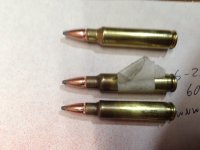Hey fellas. I did some reloading yesterday and looking over upon seating bullets I noticed a few with squashed shoulders. I realized my lube pad was getting a bit dry(was taking a bit more effort on the press) near the end of my sizing run but I thought I could squeeze by(no pun intended).
It was a mixed batch of brass, LC and Win. The only ones that were affected were the LC with their noticeable annealing marks.
I suppose it's possible that the last rounds( the ones that didn't get enough lube) were all LC, but that seems like a stretch being as the batch consisted of 100 rds and of the twenty that were LC 18 were affected.
So my question is, could it be the LC is annealed that far(soft) to cause it over the Win.?
These rounds I could not get the bolt to lock up in my AR. But without a mag dropping them in one at a time and releasing the bolt they would shoot fine. Just curious on others thoughts.
Pic of the worst ones vs a Win.
It was a mixed batch of brass, LC and Win. The only ones that were affected were the LC with their noticeable annealing marks.
I suppose it's possible that the last rounds( the ones that didn't get enough lube) were all LC, but that seems like a stretch being as the batch consisted of 100 rds and of the twenty that were LC 18 were affected.
So my question is, could it be the LC is annealed that far(soft) to cause it over the Win.?
These rounds I could not get the bolt to lock up in my AR. But without a mag dropping them in one at a time and releasing the bolt they would shoot fine. Just curious on others thoughts.
Pic of the worst ones vs a Win.

